
The Boletaceae are a family of mushroom-forming fungi, primarily characterised by small pores on the spore-bearing hymenial surface, instead of gills as are found in most agarics. Nearly as widely distributed as the agarics, the family is renowned for hosting some prime edible species highly sought after by mushroom hunters worldwide, such as the cep or king bolete . A number of rare or threatened species are also present in the family, that have become the focus of increasing conservation concerns. As a whole, the typical members of the family are commonly known as boletes.

Boletus is a genus of mushroom-producing fungi, comprising over 100 species. The genus Boletus was originally broadly defined and described by Carl Linnaeus in 1753, essentially containing all fungi with hymenial pores instead of gills. Since then, other genera have been defined gradually, such as Tylopilus by Petter Adolf Karsten in 1881, and old names such as Leccinum have been resurrected or redefined. Some mushrooms listed in older books as members of the genus have now been placed in separate genera. These include such as Boletus scaber, now Leccinum scabrum, Tylopilus felleus, Chalciporus piperatus and Suillus luteus. Most boletes have been found to be ectomycorrhizal fungi, which means that they form a mutualistic relationship with the roots system of certain kinds of plants. More recently, Boletus has been found to be massively polyphyletic, with only a small percentage of the over 300 species that have been assigned to Boletus actually belonging there and necessitating the description and resurrection of many more genera.
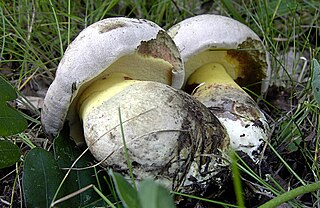
Caloboletus radicans, also known as the rooting bolete or whitish bolete, is a large ectomycorrhizal fungus found in Europe under broad-leaved trees, fruiting during the summer and autumn months. It has a pale buff or greyish-white cap, yellow pores and a stout stipe, and stains intensely blue when handled or cut. Bitter and inedible, it can cause severe vomiting and diarrhoea if eaten. Until 2014 it was placed in genus Boletus, but has since been transferred to the new genus Caloboletus based on molecular phylogenetic data.

Hortiboletus rubellus, commonly known as the ruby bolete, is a small, dainty, brightly coloured member of the family Boletaceae, with a reddish cap and stipe, and yellow pores. Like many boletes, it stains blue when cut or bruised. It is found in deciduous woodland in autumn. There is some question over its edibility, and it is reportedly of poor quality with a taste of soap. Until 2015, the species was known as Boletus rubellus.

Austroboletus is a genus of fungi in the family Boletaceae. The widely distributed genus contains species that form mycorrhizal relationships with plants.

Exsudoporus frostii, commonly known as Frost's bolete or the apple bolete, is a bolete fungus first described scientifically in 1874. A member of the family Boletaceae, the mushrooms produced by the fungus have tubes and pores instead of gills on the underside of their caps. Exsudoporus frostii is distributed in the eastern United States from Maine to Georgia, and in the southwest from Arizona extending south to Mexico and Costa Rica. A mycorrhizal species, its fruit bodies are typically found growing near hardwood trees, especially oak.

Caloboletus rubripes, commonly known as the red-stipe bolete or the red-stemmed bitter bolete, is a mushroom in the family Boletaceae. It was known as Boletus rubripes until 2014. Fruit bodies (mushrooms) are robust, with caps up to 18 cm in diameter, atop thick stipes 5–12 cm long. Mushrooms are non-toxic, but is so bitter as to be inedible. The mushroom flesh has a very strong bluing reaction when cut or damaged. and forms mycorrhizal relationships, primarily with conifers. It can be differentiated from similar boletes by its cap color and non-reticulate stipe.
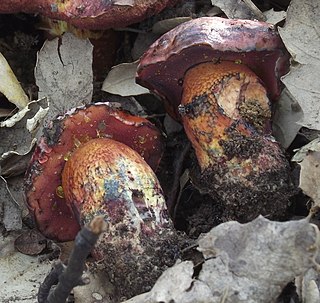
Exsudoporus permagnificus is a species of bolete fungus in the family Boletaceae, native to Southern Europe and Western Asia. Described as new to science in 1981, the fungus was originally placed in genus Boletus. Following molecular studies outlining a new phylogenetic framework for Boletaceae, the fungus was transferred to the newly erected genus Exsudoporus in 2014, to which it is the type species. Nevertheless, Wu and colleagues (2016) were reluctant to accept the newly proposed genus due to a lack of sufficient sequences and regarded it a synonym of Butyriboletus. Following studies reinstated the status of Exsudoporus as a monophyletic genus sister to Butyriboletus, following additional collections and extended phylogenetic and morphological analyses.

Xerocomellus is a genus of fungi in the family Boletaceae. The genus, as it was described in 2008, contained 12 species. However X. rubellus and X. engelii were transferred to the new genus Hortiboletus and X. armeniacus was transferred to the new genus Rheubarbariboletus in 2015. Molecular analysis supports the distinction of Xerocomellus species from Boletus and Xerocomus, within which these species were formerly contained. Xerocomellus in fact is only distantly related to Xerocomus and is most closely related to Tylopilus, Boletus sensu stricto, Porphyrellus, Strobilomyces, and Xanthoconium.
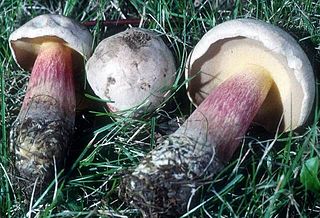
Caloboletus inedulis is a bolete fungus of the family Boletaceae that is native to North America. Until 2014, it was known as Boletus inedulis. Recent changes in the phylogenetic framework of the Boletaceae prompted the transfer of this species, along with several other related boletes, including Caloboletus calopus, to the genus Caloboletus. The species is inedible.
Butyriboletus peckii is a fungus of the genus Butyriboletus native to eastern North America. It was first described by Charles Christopher Frost in 1878. Until 2014, it was known as Boletus peckii. Recent changes in the phylogenetic framework of the Boletaceae prompted the transfer of this species, along with several other related boletes, including Caloboletus calopus, to the genus Caloboletus. In 2015, Kuan Zhao and colleagues published analysis that demonstrated that the bolete belongs to Butyriboletus, closely related to Butyriboletus pulchriceps.
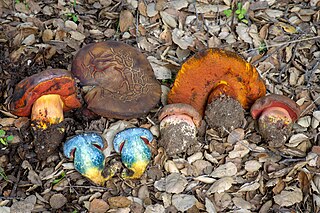
Suillellus is a genus of bolete fungi in the family Boletaceae. It was originally described by William Alphonso Murrill in 1909 with Suillellus luridus as the type species. The genus was later sunk into synonymy with Boletus, but eventually resurrected in 2014, after molecular phylogenetics research demonstrated that Suillellus species comprised a different lineage than Boletus.

Lanmaoa is a fungal genus in the family Boletaceae. It was circumscribed by Chinese mycologists Nian-Kai Zeng and Zhu L. Yang in 2015 to contain several species formerly classified in the genus Boletus, as well as the newly described Asian boletes L. angustispora and L. asiatica. The erection of this genus follows recent molecular studies that outlined a new phylogenetic framework for the family Boletaceae. Zeng and Yang named the genus after Chinese naturalist Lan Mao (1397-1476).

Neoboletus is a genus of fungi in the family Boletaceae, native to holarctic regions. It was circumscribed in 2014 by Italian mycologists Matteo Gelardi, Giampaolo Simonini and Alfredo Vizzini, and further by Chinese mycologists Gang Wu and Zhu L. Yang in 2015. Closely related to the genus Sutorius, members of this genus differ by staining blue when bruised. They have brown pores and lack a reticulated pattern on their stipes. The erection of Neoboletus follows recent molecular studies that outlined a new phylogenetic framework for the Boletaceae. The type species is Neoboletus luridiformis. Five species were added to the genus by Gelardi and Vizzini in 2014.

Caloboletus is a fungal genus in the family Boletaceae. It was circumscribed by Italian mycologist Alfredo Vizzini with Caloboletus calopus as the type species. The erection of Caloboletus follows recent molecular studies that outlined a new phylogenetic framework for the Boletaceae. Boletus peckii was also transferred to this genus by Vizzini, but was subsequently moved to the genus Butyriboletus based on molecular evidence. The generic name Caloboletus, derived from the Greek calos "nice", refers to the attractive red coloring of the stipe.

Caloboletus frustosus is a bolete fungus native to North America. Until 2014, it was known as Boletus frustosus. Recent changes in the phylogenetic framework of the family Boletaceae prompted the transfer of this species, along with several other related boletes, including Caloboletus calopus, to the genus Caloboletus. It was first described scientifically in 1941 by mycologists Wally Snell and Esther Dick.
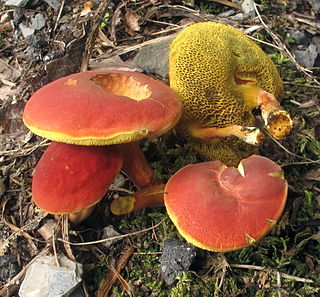
Hortiboletus is a genus of fungi in the family Boletaceae. It was circumscribed in 2015 by Giampaolo Simonini, Alfredo Vizzini, and Matteo Gelardi. The erection of Hortiboletus follows recent molecular studies that outlined a new phylogenetic framework for the Boletaceae. Hortiboletus is derived from the Latin word hortus "garden", referring to a typical habitat of the type species, Hortiboletus rubellus. The bolete H. bubalinus, originally described as a Boletus and later placed in Xerocomus, was transferred to the genus by Bálint Dima. In 2015, Alona Yu. Biketova transferred Boletus campestris and Boletus engelii to Hortiboletus.
Caloboletus panniformis is a bolete fungus native to Honshu island in Japan, where it grows under conifers in subalpine regions. Until 2014, it was known as Boletus panniformis. Recent changes in the phylogenetic framework of the family Boletaceae prompted the transfer of this species, along with several other related boletes, including Caloboletus calopus, to the genus Caloboletus. It was first described scientifically in 2013 by Japanese botanist Haruki Takahashi and colleagues.
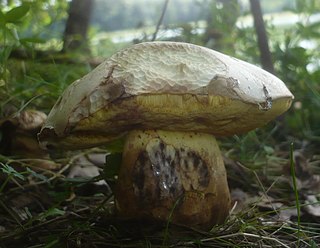
Caloboletus kluzakii is a bolete fungus native to Europe. Until 2014, it was known as Boletus kluzakii. Recent changes in the phylogenetic framework of the family Boletaceae prompted the transfer of this species, along with several other related boletes, including Caloboletus calopus, to the genus Caloboletus. It was described scientifically in 2006 by Josef Šutara and Pavel Špinar, from specimens collected in the Czech Republic. The fungus had earlier been published with the name Boletus fallax by Czech mycologist Zdeněk Kluzák in 1988, but this was invalid, as that name had been used previously by E.J.H. Corner for a Malaysian bolete. The epithet honours Kluzák's contributions in describing the species.

Exsudoporus is a genus of fungi in the family Boletaceae. It was circumscribed in 2014 by Alfredo Vizzini and colleagues, following a number of molecular studies that outlined a new phylogenetic framework for Boletaceae and revealed the genus Boletus in its traditional circumscription to be polyphyletic. However, due to lack of sufficient sequences, Wu and colleagues (2016) were reluctant to accept the newly proposed genus and considered it a synonym of Butyriboletus. Following additional phylogenetic sequencing and morphological analyses, Exsudoporus was clearly resolved as a monophyletic, homogenous and independent genus that is sister to Butyriboletus.

















